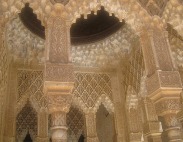
La Alhambra
La Alhambra in Granada is a palace that was built by the Moors in the 14th century. It’s a great tourist attraction and one of the most visited palaces in all of Spain. Its beautiful design – both inside and out – is a great example of Islamic architecture. Plus, visitors can tour its lush gardens and additional buildings and designs that were inspired by Christian builders.
La Alhambra’s History
La Alhambra was constructed in Southern Spain during the 14th century and was the capital of the Moorish ruler Ibn al-Ahmar. It was named La Alhambra – meaning “the red fortress” – because of its red walls and towers that can be clearly seen on the hilltop where the mighty fortress sits. One of the coolest things about La Alhambra is the amazing engineering feet undertaken by Ibn al-Ahmar to supply running water to the palace by diverting the River Darro nearly 8 km.
After the Reconquista, the famous king and queen Fernando and Isabel lived within La Alhambra’s walls for several years. They converted the mosque but left the overall structure of the palace unaltered. In 1812, Napoleon’s forces occupied the palace, looting and damaging large portions of it. In fact, Napoleon’s men tried to blow up the entire palace with bombs. However, this attempt was stopped by a crippled soldier who stayed behind to diffuse the bombs.
In the 19th century, the palace was “rediscovered” by European scholars and archeologists. Many people began to write romantic poems, stories and songs about the La Alhambra. Because of the large interest in La Alhambra, it became a Spanish national monument and funds were set aside for its restoration.
La Alhambra’s Beautiful Layout
There are many gorgeous rooms and structures within this large palace that display the lavish rooms, columns, mirrors and calligraphy associated with Islamic architecture. Below are some of the most visited and best structures within the palace:
Puerta de la Justicia (Tower of Justice): Built in 1348, this was the original entrance to La Alhambra.
Royal Complex: This beautiful area was used for business and administration. Its decorative ceiling and floor were constructed with dark wood and are beautiful to see.
Court of the Lions: This stunning pavilion is inlayed with colored tiles and white marble columns. In the center there is a fountain surrounded by tigers.
Hall of the Abencerrajes: This room displays a vaulted ceiling and its roof is decorated in gold, red, blue and brown trim. The room is a perfect square with a fountain in the middle.
 Follow
Follow


